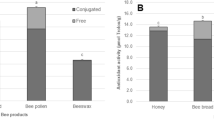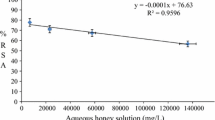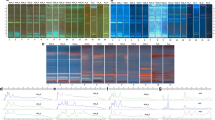Abstract
The aim of this study was to analyze the total phenolic content, phenolic profile, and antioxidant activity of honey, bee pollen, and propolis samples from Turkey's Black Sea Region. The total phenolic content of these bee products was found using Folin–Ciocalteu's method, and their antioxidant capacity was found using the 2,2-diphenyl-1-picrylhydrazyl (DPPH) and cupric ion reducing antioxidant capacity (CUPRAC) assays. Phenolic compounds of honey samples were characterized by high-performance liquid chromatography coupled to a photodiode array detector and mass spectrometer (HPLC–DAD–ESI-MS), while phenolic compounds of bee pollen and propolis samples were quantified ultra-fast liquid chromatography (UFLC). The total phenolic values for honey, bee pollen and propolis were 6.32–18.21 mg GAE/100 g, 547.64–769.4 mg GAE/100 gr, and 6096.1–11,564 mg GAE/100 gr, respectively. DPPH and CUPRAC values of honey, pollen and propolis were 11.05–21.38% and 0.38–1.48 µmol Trolox/g; 24.67–38.63% and 0.03–0.05 mmol Trolox/g; 11.81–34.12% and 0.47–0.89 mmol Trolox/g, respectively. About 30 different phenolic compounds were identified as quantitative. Our findings have shown that all bee products examined in the study are found to contain gallic acid, naringenin, and caffeic acid. In terms of total phenolic content and antioxidant activity, the bee product extracts were ranked as follows: propolis > bee pollen > honey. The high concentration of phenolic compounds in propolis explains its remarkable antioxidant effect.
Similar content being viewed by others
Data availability
The datasets generated during and/or analyzed during the current study are available from the corresponding author upon reasonable request.
References
Kasprzyk I, Depciuch J, Grabek-Lejko D, Parlinska-Wojtan M (2018) FTIR-ATR spectroscopy of pollen and honey as a tool for unifloral honey authentication. The case study of rape honey. Food Control 84:33–40. https://doi.org/10.1016/j.foodcont.2017.07.015
Khan SU, Anjum SI, Rahman K, Ansari MJ, Khan WU, Kamal S, Khattak B, Muhammed A, Khan HU (2018) Honey: Single food stuff comprises many drugs. Saudi J Biol Sci 25:320–325. https://doi.org/10.1016/j.sjbs.2017.08.004
Meo SA, Al-Asiri SA, Mahesar AL, Ansari MJ (2017) Role of honey in modern medicine. Saudi J Biol Sci 24:975–978. https://doi.org/10.1016/j.sjbs.2016.12.010
Pasias IN, Kiriakou IK, Kaitatzis A, Koutelidakis AE, Proestos C (2018) Effect of late harvest and floral origin on honey antibacterial properties and quality parameters. Food Chem 242:513–518. https://doi.org/10.1016/j.foodchem.2017.09.083
Badolato M, Carullo G, Cione E et al (2017) From the hive: Honey, a novel weapon against cancer. Eur J Med Chem 142:290–299. https://doi.org/10.1016/j.ejmech.2017.07.064
Bueno-Costa FM, Zambiazi RC, Bohmer BW, Clasen Chaves F, da Silva WP, Zanusso JT, Dutra I (2016) Antibacterial and antioxidant activity of honeys from the state of Rio Grande do Sul, Brazil. LWT Food Sci Technol 65:333–340. https://doi.org/10.1016/j.lwt.2015.08.018
Ramos OY, Salomón V, Libonatti C, Cepeda R, Maldonado L, Basualdo MOY, Salomón V, Libonatti C (2018) Effect of botanical and physicochemical composition of Argentinean honeys on the inhibitory action against food pathogens. LWT Food Sci Technol 87:457–463. https://doi.org/10.1016/j.lwt.2017.09.014
Demir E, Bayram NE (2018) Specifying some quality characteristics of monofloral and multifloral honey samples. Hacettepe J Biol Chem 3:417–423. https://doi.org/10.15671/hjbc.2018.249
Feás X, Vázquez-Tato MP, Estevinho L, Seijas JA, Iglesias AX, Vazquez-Tato MP, Estevinho L (2012) Organic bee pollen: botanical origin, nutritional value, bioactive compounds, antioxidant activity and microbiological quality. Molecules 17:8359–8377. https://doi.org/10.3390/molecules17078359
De Melo AAM, Almeida-Muradian LB (2017) Chemical composition of bee pollen. In: José A-S (ed) Bee products—chemical and biological properties. Springer, pp 1–306
Campos MG, Markham KR, Cunha A (1997) Bee-pollen: composition, properties, and applications. In: Mizrahi A, Lensky Y (eds) Bee products: properties, applications, and apitherapy. Springer US, Boston, pp 93–100
Kostić AT, Barać MB, Stanojević SP, Milojković-Opsenica DM, Tešić ŽL, Šikoparija B, Radišić P, Prentović M, Pešić MB (2015) Physicochemical composition and techno-functional properties of bee pollen collected in Serbia. LWT - Food Sci Technol 62:301–309. https://doi.org/10.1016/j.lwt.2015.01.031
Ares AM, Valverde S, Bernal JL, Nozal MJ, Bernal J (2018) Extraction and determination of bioactive compounds from bee pollen. J Pharm Biomed Anal 147:110–124. https://doi.org/10.1016/j.jpba.2017.08.009
Coelho J, Falcão SI, Vale N (2017) Composición fenólica y evaluación de la actividad antioxidante de los propóleos del sureste y sur de Brasil. J Apic Res 56:21–31. https://doi.org/10.1080/00218839.2016.1277602
Ristivojević P, Dimkić I, Guzelmeric E, Trifković J, Knežević M, Berić T, Yesilada E, Milojković-Opsenica D, Stanković S (2018) Profiling of Turkish propolis subtypes: comparative evaluation of their phytochemical compositions, antioxidant and antimicrobial activities. LWT Food Sci Technol 95:367–379. https://doi.org/10.1016/j.lwt.2018.04.063
Escriche I, Juan-Borrás M (2018) Standardizing the analysis of phenolic profile in propolis. Food Res Int 106:834–841. https://doi.org/10.1016/j.foodres.2018.01.055
Bayram S, Bayram NE, Gerçek YC, Sorkun K (2016) Anticytotoxic and antimutagenic effects of propolis on human lymphocytes in vitro. Mellifera 16:38–46
Afata TN, Nemo R, Ishete N, Tucho GT, Dekebo A (2022) Phytochemical investigation, physicochemical characterization, and antimicrobial activities of Ethiopian propolis. Arab J Chem 15:103931. https://doi.org/10.1016/j.arabjc.2022.103931
Peixoto M, Freitas AS, Cunha A, Oliveira R, Almeida-Aguiar C (2021) Antioxidant and antimicrobial activity of blends of propolis samples collected in different years. LWT Food Sci Technol 145:111311. https://doi.org/10.1016/j.lwt.2021.111311
Batista CM, Alves AVF, Queiroz LA, Lima BS, Araújo AAS, de Albuquerque Júnior RLC, Cardoso JC (2018) The photoprotective and anti-inflammatory activity of red propolis extract in rats. J Photochem Photobiol B Biol 180:198–207. https://doi.org/10.1016/j.jphotobiol.2018.01.028
Rufatto LC, dos Santos DA, Marinho F, Henriques JAP, Ely MR, Moura S (2017) Red propolis: chemical composition and pharmacological activity. Asian Pac J Trop Biomed 7:591–598. https://doi.org/10.1016/j.apjtb.2017.06.009
Bayram NE, Karadayı M, Güllüce M, Bayram S, Sorkun K, Öz GC, Salih B (2015) Genotoxic and antigenotoxic evaluation of propolis by using in vitro bacterial assay systems. Mellifera 15:29–36
Gómez-Caravaca AM, Gómez-Romero M, Arráez-Román D, Segura-Carretero A, Fernández-Gutiérrez A (2006) Advances in the analysis of phenolic compounds in products derived from bees. J Pharm Biomed Anal 41:1220–1234. https://doi.org/10.1016/j.jpba.2006.03.002
Bankova V (2005) Chemical diversity of propolis and the problem of standardization. J Ethnopharmacol 100:114–117. https://doi.org/10.1016/j.jep.2005.05.004
Chen YW, Ye SR, Ting C, Yu YH (2018) Antibacterial activity of propolins from Taiwanese green propolis. J Food Drug Anal 26:761–768. https://doi.org/10.1016/j.jfda.2017.10.002
Bayram NE, Sorkun K, Öz GC, Salih B, Topçu G (2018) Chemical characterization of 64 propolis samples from Hakkari, Turkey. Rec Nat Prod 12:569–581. https://doi.org/10.25135/rnp.78.16.12.585
Gašić U, Kečkeš S, Dabić D, Trifković J, Milojković-Opsenica D, Natić M, Tešić Ž (2014) Phenolic profile and antioxidant activity of Serbian polyfloral honeys. Food Chem 145:599–607. https://doi.org/10.1016/j.foodchem.2013.08.088
Wahdan HAL (1998) Causes of the antimicrobial activity of honey. Infection 26:26–31. https://doi.org/10.1007/BF02768748
de Almeida JF, dos Reis AS, Heldt LFS, Pereira D, Bianchin M, de Moura C, Carpes ST (2017) Lyophilized bee pollen extract: a natural antioxidant source to prevent lipid oxidation in refrigerated sausages. LWT Food Sci Technol 76:299–305. https://doi.org/10.1016/j.lwt.2016.06.017
Andrade JKS, Denadai M, de Oliveira CS, Nunes ML, Narain N (2017) Evaluation of bioactive compounds potential and antioxidant activity of brown, green and red propolis from Brazilian northeast region. Food Res Int 101:129–138. https://doi.org/10.1016/j.foodres.2017.08.066
Şensu E, Kasapoğlu KN, Gültekin-Özgüven M, Demircan E, Arslaner A, Özçelik B (2021) Orange, red and purple barberries: effect of in-vitro digestion on antioxidants and ACE inhibitors. Lwt. https://doi.org/10.1016/j.lwt.2020.110820
Singh RP, Chidambara Murthy KN, Jayaprakasha GK (2002) Studies on the antioxidant activity of pomegranate (Punica granatum) peel and seed extracts using in vitro models. J Agric Food Chem 50:81–86. https://doi.org/10.1021/jf010865b
Kumaran A, Joel Karunakaran R (2006) Antioxidant and free radical scavenging activity of an aqueous extract of Coleus aromaticus. Food Chem 97:109–114. https://doi.org/10.1016/j.foodchem.2005.03.032
Rai S, Wahile A, Mukherjee K, Saha BP, Mukherjee PK (2006) Antioxidant activity of Nelumbo nucifera (sacred lotus) seeds. J Ethnopharmacol 104:322–327. https://doi.org/10.1016/j.jep.2005.09.025
Chua LS, Rahaman NLA, Adnan NA, Eddie Tan TT (2013) Antioxidant activity of three honey samples in relation with their biochemical components. J Anal Methods Chem. https://doi.org/10.1155/2013/313798
Apak R, Güçlü K, Özyürek M, Karademir SE (2004) Novel total antioxidant capacity index for dietary polyphenols and vitamins C and E, using their cupric ion reducing capability in the presence of neocuproine: CUPRAC method. J Agric Food Chem 52:7970–7981. https://doi.org/10.1021/jf048741x
Biluca FC, da Silva B, Caon T, Mohr ETB, Vieira GN, Gonzaga LV, Costa ACO (2020) Investigation of phenolic compounds, antioxidant and anti-inflammatory activities in stingless bee honey (Meliponinae). Food Res Int 129:108756. https://doi.org/10.1016/j.foodres.2019.108756
Moniruzzaman M, Amrah Sulaiman S, Gan SH (2017) Phenolic acid and flavonoid composition of malaysian honeys. J Food Biochem 41:1–8. https://doi.org/10.1111/jfbc.12282
Güneş ME, Şahin S, Demir C, Borum E, Tosunoğlu A (2017) Determination of phenolic compounds profile in chestnut and floral honeys and their antioxidant and antimicrobial activities. J Food Biochem 41:1–12. https://doi.org/10.1111/jfbc.12345
Kečkeš S, Gašić U, Veličković TĆ, Milojković-Opsenica D, Natić M, Tešić Ž (2013) The determination of phenolic profiles of Serbian unifloral honeys using ultra-high-performance liquid chromatography/high resolution accurate mass spectrometry. Food Chem 138:32–40. https://doi.org/10.1016/j.foodchem.2012.10.025
Can Z, Yildiz O, Sahin H, Turumtay EA, Silici S, Kolayli S (2015) An investigation of Turkish honeys: Their physico-chemical properties, antioxidant capacities and phenolic profiles. Food Chem 180:133–141. https://doi.org/10.1016/j.foodchem.2015.02.024
Jasicka-Misiak I, Poliwoda A, Dereń M, Kafarski P (2012) Phenolic compounds and abscisic acid as potential markers for the floral origin of two Polish unifloral honeys. Food Chem 131:1149–1156. https://doi.org/10.1016/j.foodchem.2011.09.083
Spilioti E, Jaakkola M, Tolonen T, Lipponen M, Virtanen V, Chinou I, Moutsatsou, (2014) Phenolic acid composition, antiatherogenic and anticancer potential of honeys derived from various regions in Greece. PLoS ONE 9:1–10. https://doi.org/10.1371/journal.pone.0094860
Kıvrak Ş, Kıvrak İ (2017) Assessment of phenolic profile of Turkish honeys. Int J Food Prop 20:864–876. https://doi.org/10.1080/10942912.2016.1188307
da Silva IAA, da Silva TMS, Camara CA, Queiroz N, Magnani M, de Novais JS, de Souza AG (2013) Phenolic profile, antioxidant activity and palynological analysis of stingless bee honey from Amazonas, Northern Brazil. Food Chem 141:3552–3558. https://doi.org/10.1016/j.foodchem.2013.06.072
Cheng N, Ren N, Gao H, Lei X, Zheng J, Cao W (2013) Antioxidant and hepatoprotective effects of Schisandra chinensis pollen extract on CCl4-induced acute liver damage in mice. Food Chem Toxicol 55:234–240. https://doi.org/10.1016/j.fct.2012.11.022
Serra Bonvehi J, Soliva Torrentó M, Centelles Lorente E (2001) Evaluation of polyphenolic and flavonoid compounds in honeybee-collected pollen produced in Spain. J Agric Food Chem 49:1848–1853. https://doi.org/10.1021/jf0012300
Aličić D, Šubarić D, Jašić M, Pašalić H, Ačkar Đ (2014) Antioxidant properties of pollen. Hrana u Zdr i Boles Znan časopis za Nutr i dijetetiku 3:6–12
Huang S, Zhang CP, Wang K, Li GQ, Hu FL (2014) Recent advances in the chemical composition of propolis. Molecules 19:19610–19632. https://doi.org/10.3390/molecules191219610
Omene C, Kalac M, Wu J, Marchi E, Frenkel K, O’Connor OA (2013) Propolis and its active component, Caffeic acid phenethyl ester (CAPE), modulate breast cancer therapeutic targets via an epigenetically mediated mechanism of action. J Cancer Sci Ther 5:334–342. https://doi.org/10.4172/1948-5956.1000224
Xu Y, Luo L, Chen B, Fu Y (2009) Recent development of chemical components in propolis. Front Biol China 4:385–391. https://doi.org/10.1007/s11515-009-0053-2
Can Z, Yıldız O, Şahin H, Asadov A, Kolayli S (2015) Phenolic profile and antioxidant potential of propolis from Azerbaijan. Mellifera 15:16–28
Falcão SI, Vale N, Gomes P, Domingues MR, Freire C, Cardoso SM, Vilas-Boas M (2013) Phenolic profiling of Portuguese propolis by LC-MS spectrometry: Uncommon propolis rich in flavonoid glycosides. Phytochem Anal 24:309–318. https://doi.org/10.1002/pca.2412
Gül A, Pehlivan T (2018) Antioxidant activities of some monofloral honey types produced across Turkey. Saudi J Biol Sci 25:1056–1065. https://doi.org/10.1016/j.sjbs.2018.02.011
do Nascimento KS, Sattler JAG, Macedo LFL, González CVS, de Melo ILP, da Silva Araújo E, do Almeida-Muradian LBKS, Gasparotto Sattler JA, Lauer Macedo LF (2018) Phenolic compounds, antioxidant capacity and physicochemical properties of Brazilian Apis mellifera honeys. LWT Food Sci Technol 91:85–94. https://doi.org/10.1016/j.lwt.2018.01.016
Perna A, Intaglietta I, Simonetti A, Gambacorta E (2013) A comparative study on phenolic profile, vitamin C content and antioxidant activity of Italian honeys of different botanical origin. Int J Food Sci Technol 48:1899–1908. https://doi.org/10.1111/ijfs.12169
Socha R, Juszczak L, Pietrzyk S, Gałkowska D, Fortuna T, Witczak T (2011) Phenolic profile and antioxidant properties of Polish honeys. Int J Food Sci Technol 46:528–534. https://doi.org/10.1111/j.1365-2621.2010.02517.x
Boussaid A, Chouaibi M, Rezig L, Hellal R, Donsì F, Ferrari G, Hamdi S (2018) Physicochemical and bioactive properties of six honey samples from various floral origins from Tunisia. Arab J Chem 11:265–274. https://doi.org/10.1016/j.arabjc.2014.08.011
Ecem Bayram N, Yüzer MO, Bayram S (2019) Melissopalynology analysis, physicochemical properties, multi-element content and antimicrobial activity of honey samples collected from Bayburt, Turkey. Uludag Bee J 19(2):161–176
Ecem Bayram N, Kara HH, Muslu Can A, Bozkurt F, Akman PK, Vardar SU, Dertli E (2020) Characterization of physicochemical and antioxidant properties of Bayburt honey from north-east part of Turkey. J Apic Res 60(1):46–56
Mouhoubi-Tafinine Z, Ouchemoukh S, Tamendjari A (2016) Antioxydant activity of some algerian honey and propolis. Ind Crops Prod 88:85–90. https://doi.org/10.1016/j.indcrop.2016.02.033
Laskar RA, Sk I, Roy N, Begum NA (2010) Antioxidant activity of Indian propolis and its chemical constituents. Food Chem 122:233–237. https://doi.org/10.1016/j.foodchem.2010.02.068
Sarikaya AO, Ulusoy E, ÖztÜrk N, Tuncel M, Kolayli S (2009) Antioxidant activity and phenolic acid constituents of chestnut (Castania sativa Mill.) honey and propolis. J Food Biochem 33:470–481. https://doi.org/10.1111/j.1745-4514.2009.00231.x
Dumbrava DG, Bordean DM, Raba DN, Druga M, Moldovan C, Popa MV (2013) Antioxidant properties and other physicochemical characteristics of some honey varieties from west Romanian area. In: International Multidisciplinary Scientific GeoConference: SGEM: Surveying Geology & mining Ecology Management, p 101
Jerković I, Marijanović Z, Zekić M, Tuberoso CIG (2017) First report on rare unifloral honey of endemic Moltkia petraea (Tratt.) Griseb. from Croatia: detailed chemical screening and antioxidant capacity. Chem Biodivers. https://doi.org/10.1002/cbdv.201600268
Kalaycıoğlu Z, Kaygusuz H, Döker S, Kolaylı S, Erim FB (2017) Characterization of Turkish honeybee pollens by principal component analysis based on their individual organic acids, sugars, minerals, and antioxidant activities. LWT Food Sci Technol 84:402–408. https://doi.org/10.1016/j.lwt.2017.06.003
Ulusoy E, Kolayli S (2014) Phenolic composition and antioxidant properties of anzer bee pollen. J Food Biochem 38:73–82. https://doi.org/10.1111/jfbc.12027
Nina N, Quispe C, Jiménez-Aspee F, Theoduloz C, Giménez A, Schmeda-Hirschmann G (2016) Chemical profiling and antioxidant activity of Bolivian propolis. J Sci Food Agric 96:2142–2153. https://doi.org/10.1002/jsfa.7330
Martin-Benlloch X, Novodomska A, Jacquemin D, Davioud-Charvet E, Elhabiri M (2018) Iron(iii) coordination properties of ladanein, a flavone lead with a broad-spectrum antiviral activity. New J Chem 42:8074–8087. https://doi.org/10.1039/c7nj04867j
Martin-Benlloch X, Haid S, Novodomska A, Rominger F, Pietschmann T, Davioud-Charvet E, Elhabiri M (2019) physicochemical properties govern the activity of potent antiviral flavones. ACS Omega 4:4871–4887. https://doi.org/10.1021/acsomega.8b03332
Acknowledgements
This work was supported by research fund of the Istanbul Technical University, under Project No. 41275.
Author information
Authors and Affiliations
Corresponding author
Ethics declarations
Conflict of interest
The authors declare that they have no conflict of interest.
Compliance with ethics requirements
The authors declare that the study does not contain any studies involving animals.
Additional information
Publisher's Note
Springer Nature remains neutral with regard to jurisdictional claims in published maps and institutional affiliations.
Rights and permissions
Springer Nature or its licensor (e.g. a society or other partner) holds exclusive rights to this article under a publishing agreement with the author(s) or other rightsholder(s); author self-archiving of the accepted manuscript version of this article is solely governed by the terms of such publishing agreement and applicable law.
About this article
Cite this article
Saroğlu, Ö., Ecem Bayram, N. & Özçelik, B. Comparison of bioactive constituents by HPLC–DAD–ESI-MS and UFLC and in vitro antioxidant activities of blossom honey, bee pollen, and propolis. Eur Food Res Technol 249, 3085–3096 (2023). https://doi.org/10.1007/s00217-023-04350-6
Received:
Revised:
Accepted:
Published:
Issue Date:
DOI: https://doi.org/10.1007/s00217-023-04350-6




